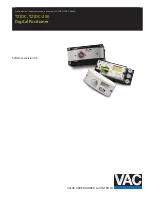
Functions
7100.006434_Bus description_PSD4xx_IO_J_ENG
52
2022-09-13
3.10.
Modulo function
(Available from firmware V19 for variants with the feature “Software modules” = “M” or “Z”)
Operating principle:
The modulo function allows the user to have the device process the transmitted target position as
a modulo position instead of as a continuous target position. This can be used to cover
applications in which, for example, it is driving a
turntable
.
The user specifies a range for target and actual values, as in normal operation. In modulo mode,
the limits of this range are called “Lower modulo position” or “Upper modulo position”. The special
feature of the modulo mode is that the modulo range repeats infinitely upwards and downwards,
i.e. in this operating mode there are no limits to the positioning range
– thus it is possible to make
an infinite number of positioning runs in the same direction.
A characteristic feature of these applications is that after a certain distance, the entire
arrangement is back in its initial state. e.g. for a turntable, where the axle is driven directly (i.e.
without a gearbox), this would be the case after exactly one turn of the turntable.
The distance after which the arrangemen
t is back in the initial state is called the “modulo width”.
The modulo width is determined by specifying the parameters “Upper modulo position” and
“Lower modulo position”:
Modulo width
= Upper modulo position - Lower modulo position
The modulo mode distinguishes between five sub-modes; the following parameters are therefore
relevant for the modulo function:
1) Modulo mode (ISDU 184)
2) Upper modulo position (ISDU 185)
3) Lower modulo position (ISDU 186)
Processing the target position in modulo mode:
When the modulo function is activated, the target position is placed in the modulo range
– taking
into account the modulo width
– in such a way that the difference between the transmitted target
position and the position actually approached is an integer multiple of the modulo width.
Example:
-
Upper modulo position = 360 (ISDU 185)
-
Lower Modulo position = 0 (ISDU 186)
-
Transmitted target position = 450
Device runs to position 90.
Calculation of the actual position:
Likewise, the device outputs the actual position so that the value is always within the modulo
range:
Lower
modulo position ≤ Actual position < Upper
modulo position
The following rules apply:
When the value for the actual position increases, the actual position jumps to the value
“Lower modulo position” as soon as the value [Upper modulo position - 1] is exceeded.

























